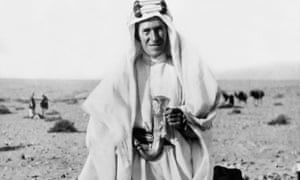
A tantalising find in the Arabian desert may help cast new light on TE Lawrence’s account of his part in the Arab revolt a hundred years ago.
Archaeologists who have spent a decade excavating dozens of sites associated with the 1916-18 conflict have uncovered a bullet that was probably fired by the man who became known as Lawrence of Arabia.
It was found during fieldwork at Halat Ammar, on the Saudi Arabia-Jordan border, site of an ambush that provided the famous train attack scenes in David Lean’s biopic starring Peter O’Toole.
Lawrence served as a military adviser with Arab forces fighting the Ottoman Turks, then allied with Germany. Experts from Bristol University, who have led the Great Arab Revolt Project, believe the find corroborates Lawrence’s own account in his war memoir, The Seven Pillars of Wisdom, and undermines the claims of some biographers that Lawrence over-embellished his stories.
Prof Nicholas Saunders said: “The bullet we found comes from a Colt automatic pistol, the type of gun known to be carried by Lawrence and almost certainly not used by any of the ambush’s other participants.”
Dr Neil Faulkner said: “Lawrence has something of a reputation as a teller of tall tales but this bullet – and the other archaeological evidence we unearthed during 10 years of fieldwork – indicates how reliable his account of the Arab revolt in Seven Pillars of Wisdom is.”
Both experts have books in the pipeline. Faulkner’s Lawrence of Arabia’s War, to be published by Yale University Press later this month, aims to rewrite the history of the maverick’s legendary military campaigns, looking too at the decline of the Ottoman Empire, the role of Bedouin tribes, growing Arab nationalism and western imperial ambition.
Saunders’ book, Desert Insurgency: Archaeology, TE Lawrence and the Great Arab Revolt, to be published by Oxford University Press next year, will detail how findings from investigations at armoured car raiding camps, Ottoman army campsites, desert fortifications, and train ambush sites have helped chart the origins of modern guerrilla warfare.
No comments:
Post a Comment